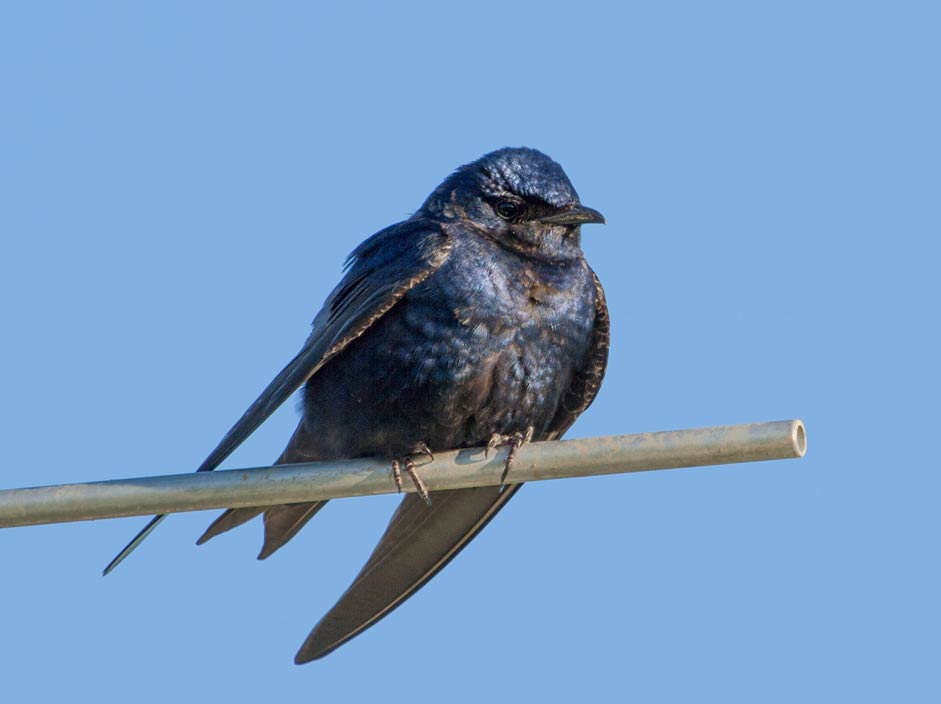Supplemental Feeding
Weather conditions that limit insect availability include temperatures below 40 degrees, steady rain, drought, or dense fog. Martins can have trouble feeding in warmer weather if it is very windy. Landlords often assume that when martins are foraging they are finding enough food for themselves and their nestlings. But when flying insects are scarce, energy spent foraging unsuccessfully can hasten starvation. Watch perched birds for drooping wings—a sign that the martin’s system is beginning to break down and digest its primary flight muscles.

In very cold weather, martins will begin communal roosting, with a dozen or more birds crowded into one compartment or gourd. Clustering together conserves body heat, allowing martins to save energy. While this is a beneficial adaption, it is a sign that martins are in survival mode and would benefit from supplemental food.

What to Feed
Crickets—Because they closely resemble grasshoppers, a natural food item, crickets make a good choice for first time supplemental feeding efforts. But of the three options, they are the most costly. Store crickets in the freezer and thaw in warm water before use.
Mealworms—Mealworms are a good source of protein for martins and other insect-eating birds. They can be purchased live or dried and are often less expensive than crickets.
Scrambled Eggs—Perhaps best accepted after martins have first learned to accept crickets or mealworms. Eggs require preparation time, but are the least expensive of the three foods and are readily available. Cook eggs in a microwave or nonstick pan without any added fat. Break into small, raisin-sized pieces before feeding.

Feeding Methods
Physical condition of the birds, severity and duration of poor weather, site specifics, and individual limitations will all play a role in what feeding technique works best for you and your birds. Be flexible—try several methods until you find one that works.
Tossing—Tossing crickets or mealworms into the air may be the best method for first-time feeding attempts, as it is closest to the martin’s natural feeding habits. Propelling food into the air requires time and effort from both the landlord and martins, and food will be missed or dropped. Landlords report the greatest success with tossing food after 2-3 days of non-feeding weather when martins are hungry enough to pursue the food but not too weak to go after it.
Platform Feeding—Offering food on a platform is ideal. This self-serve method requires minimal energy and allows martins to eat multiple items at one sitting. Since most landlords report that supplemental food is recognized as food more quickly when tossed, many transition their birds to platform feeding after they have first eaten tossed food. Tossing food right above the feeder encourages martins to land on the feeder.
In-Cavity Feeding—Mealworms and crickets can be placed inside a gourd or house compartments where they can easily be seen and eaten by roosting martins. This method can be particularly helpful during very cold temperatures or advanced stages of weakness when conservation of energy is critical. While live food often stimulates a feeding response, they tend to escape or bury themselves in nest material. Landlords can use dried or thawed insects. Another method to try is to put food in shallow dishes and fasten them to porch or cavity floors, or to interior walls. Lowering the house to add food will flush the martins but the energy expense is worthwhile if they return and eat.
For a video on supplemental feeding and how to save starving martins please visit; https://www.youtube.com/watch?v=JNcZ6ip92h0
Recommended Reading:
